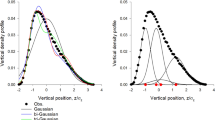Abstract
Intrinsic stochasticity associated with finite population size is fundamental to the emergence of collective behaviours in insect swarms. It has been assumed that this intrinsic stochasticity is purely additive (position independent) in quiescent (unperturbed) swarms. Here, I identify the hallmarks of intrinsic multiplicative (position dependent) stochasticity and show that they are evident in quiescent laboratory swarms of the non-biting midge Chironomus riparius. In accordance with theoretical expectations, the smallest well-documented laboratory swarms (containing between 14 and 46 individuals) are found to have q-Gaussian density profiles with \(q>\) 1, whereas larger laboratory swarms have Gaussian (\(q=\)1) density profiles. I show that these newly identified states are analogous to interstellar clouds and thereby extend a long-standing analogy between insect swarms and self-gravitating systems. Smaller laboratory swarms have been observed and are predicted to be gas-like, filling the available space rather than occupying just a small proportion of it. The new results unify laboratory swarms with wild swarms. Unlike laboratory swarms, wild swarms must contend with environmental (extrinsic) noise and have density profiles that are accurately represented by q-Gaussians with \(q<\) 1. Finally, it is shown how intrinsic multiplicative noise allows for the nucleation of swarms away from prominent visual features (basins of attraction) known as swarm markers.
Graphic abstract




Similar content being viewed by others
Data Availability Statement
This manuscript has associated data in a data repository. [Authors’ comment: The experimental data used in the present study was published by Sinhuber et al. [20].]
References
A. Okubo, Dynamical aspects of animal grouping: swarms, schools, flocks and herds. Adv. Biophys. 22, 1–94 (1986)
D.H. Kelley, N.T. Ouellette, Emergent dynamics of laboratory insect swarms. Sci. Rep. 3(1073), 1–7 (2013)
A. Attanasi et al., Collective behaviour without collective order in wild swarms of midges. PLoS Comput. Biol. 10, e1003697 (2014a)
A. Attanasi et al., Finite-size scaling as a way to probe near-criticality in natural swarms. Phys. Rev. Lett. 113, 238102 (2014)
A. Cavagna et al., Dynamic scaling in natural swarms. Nat. Phys. 13, 914–918 (2017)
J.G. Puckett, N.T. Ouellette, Determining asymptotically large population sizes in insect swarms. J. R. Soc. Int. 11, 20140710 (2014)
J.G. Puckett, D.H. Kelley, N.T. Ouellette, Searching for effective forces in laboratory insect swarms. Sci. Rep. 4, 4766 (2014)
R. Ni, N.T. Ouellette, On the tensile strength of insect swarms. Phys. Biol. 13, 045002 (2016)
M. Sinhuber, N.T. Ouellette, Phase coexistence in insect swarms. Phys. Rev. Lett. 119, 178003 (2017)
M. Sinhuber, K. van der Vaart, N.T. Ouellette, Response of insect swarms to dynamic illumination perturbations. J. R. Soc. Interface 16, 20180739 (2019)
K. van der Vaart, M. Sinhuber, A.M. Reynolds, N.T. Ouellette, Mechanical spectroscopy of insect swarms. Sci. Adv. 5, eaaw9305 (2019)
K. van der Vaart, M. Sinhuber, A.M. Reynolds, N.T. Ouellette, Environmental perturbations induce correlations in midge swarms. J. R. Soc. Interface 17, 20200018 (2020)
A.M. Reynolds, M. Sinhuber, N.T. Ouellette, Are midge swarms bound together by an effective velocity-dependent gravity? Euro. Phys. J. E 40, 46 (2017)
A.M. Reynolds, Langevin dynamics encapsulate the microscopic and emergent macroscopic properties of midge swarms. J. R. Soc. Int. 15, 20170806 (2018)
A.M. Reynolds, Fluctuating environments drive insect swarms into a new state that is robust to perturbations. Europhys. Lett. 124, 38001 (2018)
A.M. Reynolds, On the origin of the tensile strength of insect swarms. Phys. Biol. 16, 046002 (2019)
A.M. Reynolds, On the emergence of gravitational-like forces in insect swarms. J. R. Soc. Int. 16, 20190404 (2019)
A.M. Reynolds, Insect swarms can be bound together by repulsive forces. Euro. Phys. J. E. 43, 39 (2020)
S.B. Poda et al., Sex aggregation and species segregation cues in swarming mosquitoes: role of ground visual markers. Para. Vects. 12, 589 (2019)
M. Sinhuber, K. van der Vaart, R. Ni, J.G. Puckett, D.H. Kelley, N.T. Ouellette, Three-dimensional time-resolved trajectories from laboratory insect swarms. Sci. Data 6, 190036 (2019)
L. Borland, Microscopic dynamics of the nonlinear Fokker–Planck equation: a phenomenological model. Phys. Rev. E 57, 6634–6642 (1998)
C. Tsallis, Possible generalization of Boltzmann–Gibbs statistics. J. Stat. Phys. 52, 479–487 (1988)
K.P. Burnham, D.R. Anderson, Multimodal inference: understanding AIC and BIC in model selection. Soc. Methods Res. 33, 261–304 (2004)
Gorbonos, D. et al. Long-range acoustic interactions in insect swarms: an adaptive gravity model. New J. Phys. 18, 073042 (2016)
D. Gorbonos, N.S. Gov, Stable swarming using adaptive long-range interactions. Phys. Rev. E 95, 042405 (2017)
D. Gorbonos et al., Similarities between insect swarms and isothermal globular clusters. Phys. Rev. Res. 2, 013271 (2020)
A.R. Plastino, S\(_{\rm q}\) entropy and self-gravitating systems. Europhys. News 36, 208 (2005)
F.H. Shu et al., Galactic shocks in an interstellar medium with two stable phases. Astrophys. J. 173, 557–592 (1972)
Y. Viala, Structure et critères d’effondrement gravitationnel d’une sphère polytropique d’indice négatif. Comp. Rend. Acad. Sci. (Paris) 275B, 117–120 (1972)
D. Shishika et al., Male motion coordination in anopheline mating swarms. Sci. Rep. 4, 6318 (2014)
A. Diabaté et al., Spatial swarm segregation and reproductive isolation between the molecular forms of Anopheles gambiae. Proc. R. Soc. B. 276, 4215–4222 (2009)
C.A. Yates, Inherent noise can facilitate coherence in collective swarm motion. Proc. Nat. Acad. Sci. 106, 5464–5469 (2009)
J. Jhawar et al., Noise-induced schooling of fish. Nat. Phys. 16, 488–493 (2020)
Acknowledgements
The work at Rothamsted forms part of the Smart Crop Protection (SCP) strategic programme (BBS/OS/CP/000001) funded through Biotechnology and Biological Sciences Research Council’s Industrial Strategy Challenge Fund.
Author information
Authors and Affiliations
Corresponding author
Rights and permissions
About this article
Cite this article
Reynolds, A.M. Intrinsic stochasticity and the emergence of collective behaviours in insect swarms. Eur. Phys. J. E 44, 22 (2021). https://doi.org/10.1140/epje/s10189-021-00040-x
Received:
Accepted:
Published:
DOI: https://doi.org/10.1140/epje/s10189-021-00040-x




